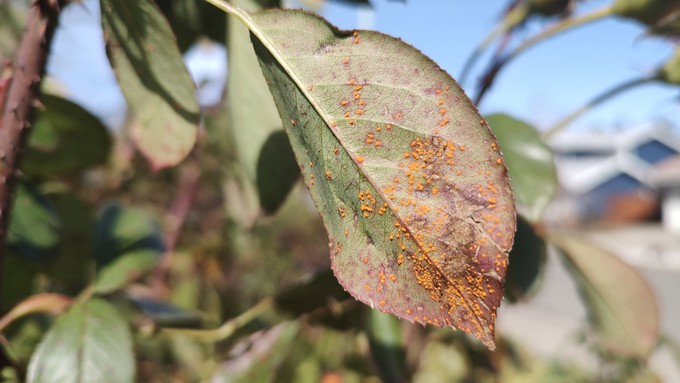
How to tackle fungal outbreaks on roses without spraying

This rose is in the grip of the fungal disease known as rust. Cleanup and warmer weather will end the outbreak. Debbie Arrington
It’s easy to spot: This colorful fungal disease gets its apt nickname from the bright orange spores that form on the underside of leaves. The top surface of foliage becomes speckled with yellow blotches.
And when the conditions are just right – as in right now – this fungal disease can quickly infect a whole rose bush, including all the new healthy shoots trying to grow.
Rose rust – Phragmidium mucronatum – needs moist conditions (such as after a storm or on foggy mornings) and temperatures in the 60s to low 70s. A constant problem in coastal areas, rust hits Sacramento in late winter to early spring and again in the fall, usually November.
This week with abundant moisture and afternoons in the 60s, rust is breaking out all over Sacramento.
This outbreak was just waiting to happen. Rust spores spend their winter dormancy on old leaves – on or off the bush. When bushes aren’t pruned before an outbreak, the spores can spring into action almost overnight. Those spores infect the new tender foliage and cause it to whither before it can develop.
Rust ultimately causes the bush to shed its infected leaves (old and new). Without leaves, a rose bush struggles to survive – never mind producing flowers.
Fortunately, most bushes will sprout new leaves. As our afternoon temperatures warm into the 80s and 90s, rust disappears; it can’t take the heat.
In the meantime, the best way to attack rust is to cut it off. Remove infected leaves and discard in the trash. Fungal sprays are a temporary solution and require repeated spraying (as well as hitting the underside of leaves). Infected leaves will fall off anyway. Skip the spray and remove the rusty foliage before the fungus spreads any further.
If a bush wasn’t pruned this winter, go ahead and prune it now – just not severely. Aim to keep the bush about 3 to 4 feet tall after pruning. Cut off any old foliage and remove any fallen leaves that may have accumulated under the bush.
When pruning, try to improve air flow through the interior of the bush by removing some canes that grow towards the center. (Encourage the bush to grow out, not in.) Better air circulation helps cut down on fungal disease development; foliage dries quicker after rain.
Rake out the old mulch under bushes, too, and replace it with fresh wood chips or other organic mulch. Old mulch can harbor dormant fungal spores, not just rust but powdery mildew and black spot.
To avoid rust outbreaks later in spring, water roses with irrigation underneath the bushes – not overhead. When using water to knock off aphids, spray bushes in the morning so the foliage has a chance to dry before the afternoon.
For more on rose diseases and prevention, check out these recommendations from the UC integrated pest management program:https://ipm.ucanr.edu/PMG/PESTNOTES/pn7463.html.
Comments
0 comments have been posted.Sacramento Digs Gardening to your inbox.
Sites We Like
Garden Checklist for week of May 5
Survey your garden after the May 4 rainstorm. Heavy rain and gusty winds can break the neck of large flowers such as roses. Also:
* Keep an eye on new transplants or seedlings; they could take a pounding from the rain.
* Watch out for powdery mildew. Warmth following moist conditions can cause this fungal disease to “bloom,” too. If you see a leaf that looks like it’s dusted with powdered sugar, snip it off.
* After the storm, start setting out tomato transplants, but wait on the peppers and eggplants (they want warmer nights). Pinch off any flowers on new transplants to make them concentrate on establishing roots instead of setting premature fruit.
* Trim dead flowers but not leaves from spring-flowering bulbs such as daffodils and tulips. Those leaves gather energy to create next year's flowers. Also, give the bulbs a fertilizer boost after bloom.
* Pinch chrysanthemums back to 12 inches for fall flowers. Cut old stems to the ground.
* Mulch around plants to conserve moisture and control weeds.
* From seed, plant beans, beets, cantaloupes, carrots, corn, cucumbers, melons, pumpkins, radishes and squash.
* Plant onion sets.
* In the flower garden, plant seeds for asters, cosmos, celosia, marigolds, salvia, sunflowers and zinnias. Transplant petunias, zinnias, geraniums and other summer bloomers.
* Plant perennials and dahlia tubers for summer bloom.
* Don’t wait; plant summer bulbs, such as gladiolus and tuberous begonias.
* Harvest cabbage, lettuce, peas and green onions.